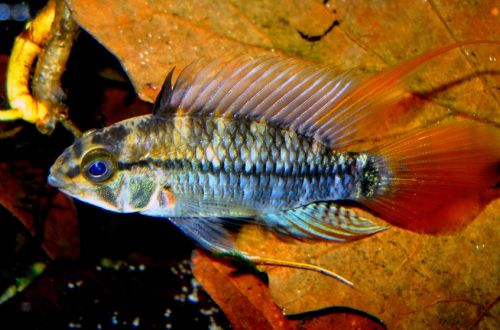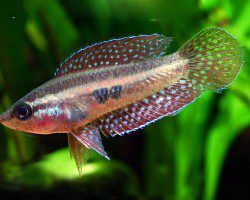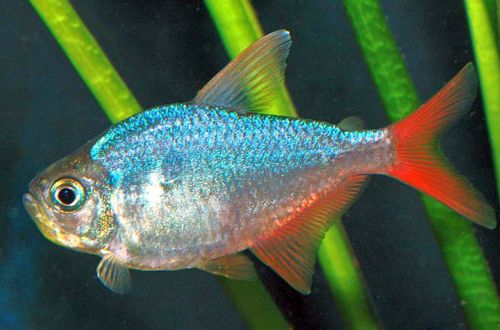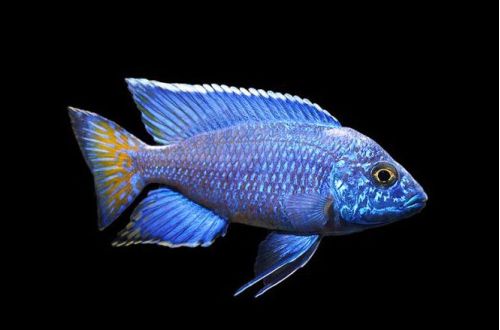
Apistogramma highfin
Apistogramma eunotus, scientific name Apistogramma eunotus, belongs to the Cichlidae family. Belongs to the group of popular South American cichlids. They are quite simple to maintain, experienced aquarists can easily breed them, but beginners may encounter a number of difficulties, primarily with the difficult behavior of males during spawning.

Contents
Habitat
It comes from South America from the territory of eastern Peru (Ucayali river basin) and western Brazil (Solimoes river basin). The terrain type is described as the Upper Amazon.
Inhabits numerous streams and rivers flowing under the canopy of the tropical forest. Prefers regions with a slow current. In the natural habitat, there are many snags and fallen leaves. This plant organic matter in the process of decomposition releases a large amount of tannins, from which the water becomes brown, but at the same time remains more or less transparent.
Brief information:
- The volume of the aquarium – from 40 liters.
- Temperature – 23-29°C
- Value pH — 5.5–7.0
- Water hardness – 0–5 dGH
- Substrate type – sandy
- Lighting – subdued
- Brackish water – no
- Water movement is weak
- The size of the fish is 4–5 cm.
- Food – small sinking food from a variety of products
- Temperament – peaceful, except during spawning periods
- Keeping in a harem with one male and several females
Description

Adults reach a length of 4–5 cm. Males are larger. The color of the body is dominated by blue and blue colors. The tail is red. The dorsal and ventral fins have elongated last rays. In dominant males, the coloration is brighter, and the rays are longer.
The females are smaller in size. The coloring is yellow. The body pattern consists of several dark large speckles along the lateral line, and a diagonal black stripe runs along the head.
Food
The basis of the diet should be foods high in protein. It can be dry food in the form of flakes or granules, as well as live or frozen brine shrimp, daphnia, bloodworms.
Maintenance and care, arrangement of the aquarium
For one or two fish, the minimum volume of the aquarium starts from 40 liters. A suitable design is one that resembles a natural habitat. It is recommended to use a soft substrate (sand), a lot of snags and plants (live or artificial). The lighting is subdued. It is necessary to provide shelters where the fish could hide. This becomes especially true during spawning, when the male begins to actively follow the female / females.
Experienced aquarists add dry leaves of some trees. With their help, the composition of water is achieved, which is characteristic of natural reservoirs in the habitats of Apistogramma high-finned. When decomposed, the leaves release tannins that contribute to the acidification of water and stain it in a characteristic brownish color. Read more in the article “Which tree leaves can be used in an aquarium.”
Successful long-term maintenance of this species of cichlids depends on the provision of stable water conditions: hydrochemical composition, temperature, low concentrations of nitrogen cycle products (ammonia, nitrites, nitrates). To this end, a number of mandatory procedures should be carried out, including weekly replacement of part of the water with fresh water, regular removal of organic waste (excrement, food debris, plaque), equipment maintenance, and water testing / testing. An important, and perhaps key, value is the filtration system. Before choosing a specific model, you should consult with a specialist so that he selects the appropriate filter for the volume of the tank and the number of fish.
Behavior and Compatibility
Apistogramma high-fin is able to live both singly and in a group. In the latter case, it is worth remembering that in a small aquarium, males will compete with each other, sometimes quite fiercely, so the composition of the group should be maintained in the form of one male and one or more females. Another feature of behavior appears during the spawning period and is again associated with the male, which shows too much attention to the female even after the eggs have been fertilized. If she has nowhere to hide, then the consequences for the latter will be sad.
Breeding / breeding
In favorable conditions, the probability of the appearance of fry is very high. During the spawning period, the female lays her eggs in a safe shelter and remains near the clutch until the offspring appears, which she will continue to protect for some more time. In a small aquarium, it is advisable to temporarily weed out the male into a separate tank.
Fish diseases
The main cause of diseases lies in the conditions of detention, if they go beyond the permissible range, then immunity suppression inevitably occurs and the fish becomes susceptible to various infections that are inevitably present in the environment. If the first suspicions arise that the fish is sick, the first step is to check the water parameters and the presence of dangerous concentrations of nitrogen cycle products. Restoration of normal/suitable conditions often promotes healing. However, in some cases, medical treatment is indispensable. Read more about symptoms and treatments in the Aquarium Fish Diseases section.





